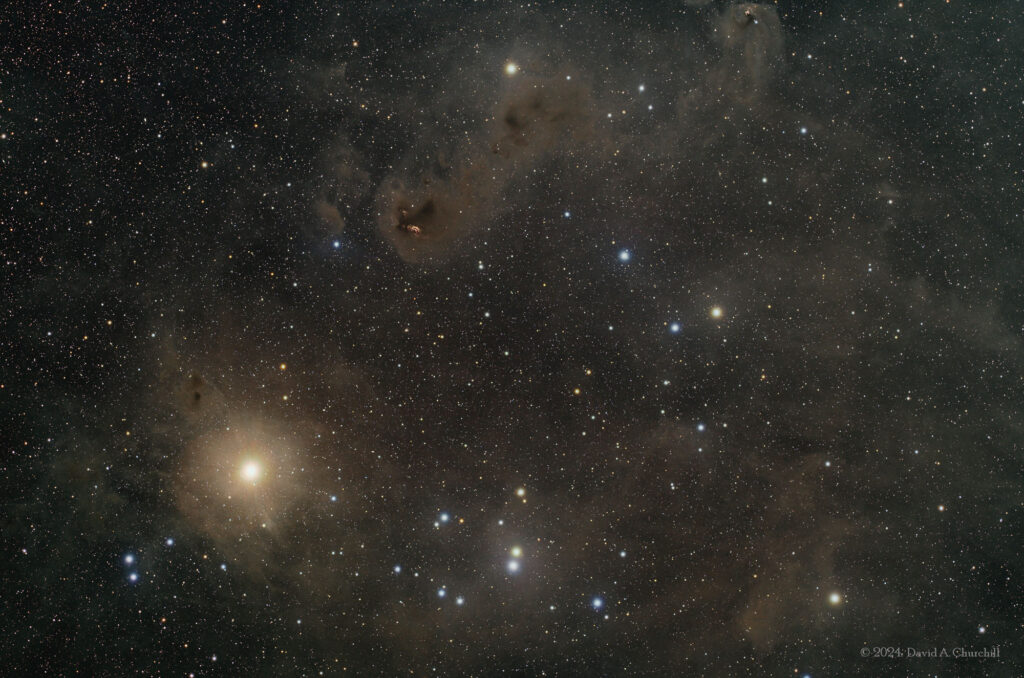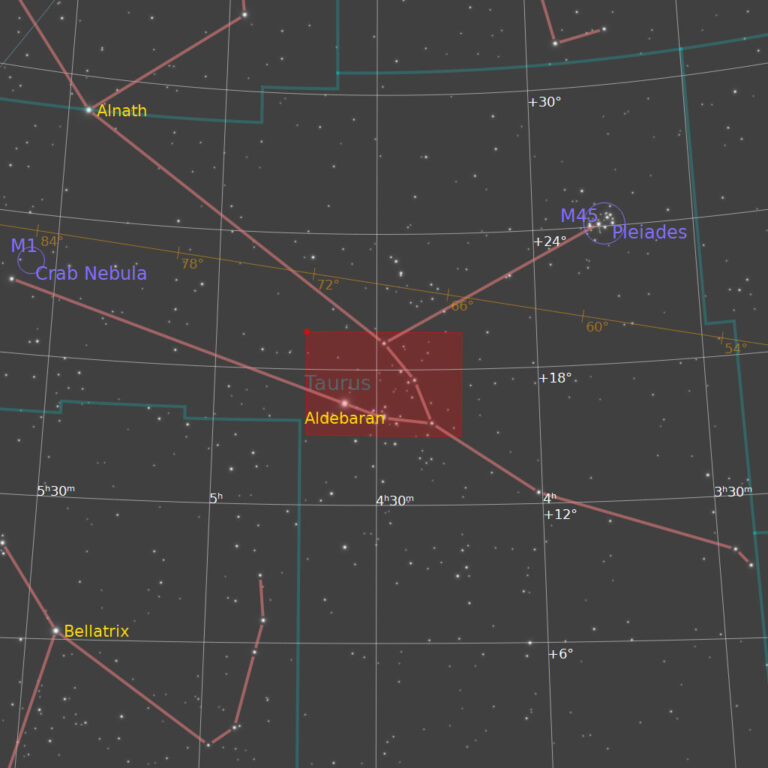Hyades (Caldwell 41)
Open Star Cluster, Taurus
October 2024. Cave Creek Canyon Observatory, Arizona Sky Village
- Description
- Technical
- Links
The Hyades (also known as Caldwell 41, Collinder 50, or Melotte 25) is the nearest open cluster and one of the best-studied star clusters. Located about 153 light-years (47 parsecs) away from the Sun, it consists of a roughly spherical group of hundreds of stars sharing the same age, place of origin, chemical characteristics, and motion through space.[1][5] From the perspective of observers on Earth, the Hyades Cluster appears in the constellation Taurus, where its brightest stars form a “V” shape along with the still-brighter Aldebaran. However, Aldebaran is unrelated to the Hyades, as it is located much closer to Earth (65 ly) and merely happens to lie along the same line of sight.
The five brightest member stars of the Hyades have consumed the hydrogen fuel at their cores and are now evolving into giant stars. Four of these stars, with Bayer designations Gamma, Delta 1, Epsilon, and Theta Tauri, form an asterism that is traditionally identified as the head of Taurus the Bull. The fifth of these stars is Theta1 Tauri, a tight naked-eye companion to the brighter Theta2 Tauri. Epsilon Tauri, known as Ain (the “Bull’s Eye”), has a gas giant exoplanet candidate, the first planet to be found in any open cluster.
The age of the Hyades is estimated to be about 625 million years. The core of the cluster, where stars are the most densely packed, has a radius of 8.8 light-years (2.7 parsecs), and the cluster’s tidal radius – where the stars become more strongly influenced by the gravity of the surrounding Milky Way galaxy – is 33 light-years (10 parsecs). However, about one-third of confirmed member stars have been observed well outside the latter boundary, in the cluster’s extended halo; these stars are probably in the process of escaping from its gravitational influence. The cluster is sufficiently close to the Sun that its distance can be directly measured by observing the amount of parallax shift of the member stars as the Earth orbits the Sun. This measurement has been performed with great accuracy using the Hipparcos satellite and the Hubble Space Telescope. An alternative method of computing the distance is to fit the cluster members to a standardized infrared color–magnitude diagram for stars of their type, and use the resulting data to infer their intrinsic brightness. Comparing this data to the brightness of the stars as seen from Earth allows their distances to be estimated. Both methods have yielded a distance estimate of 153 light-years (47 parsecs) to the cluster center. The fact that these independent measurements agree makes the Hyades an important rung on the cosmic distance ladder method for estimating the distances of extragalactic objects. The Hyades are unrelated to two other nearby stellar groups, the Pleiades and the Ursa Major Stream, which are easily visible to the naked eye under clear dark skies. Together with the other eye-catching open star cluster of the Pleiades, the Hyades form the Golden Gate of the Ecliptic, which has been known for several thousand years.
As a naked-eye object, the Hyades cluster has been known since prehistoric times. It is mentioned by numerous Classical authors from Homer to Ovid. In Book 18 of the Iliad the stars of the Hyades appear along with the Pleiades, Ursa Major, and Orion on the shield that the god Hephaistos made for Achilles. In Greek mythology, the Hyades were the five daughters of Atlas and half-sisters to the Pleiades. After the death of their brother, Hyas, the weeping sisters were transformed into a cluster of stars that was afterwards associated with rain. In England the cluster was known as the “April Rainers” from an association with April showers, as recorded in the folk song “Green Grow the Rushes, O”.
The cluster was probably first catalogued by Giovanni Battista Hodierna in 1654, and it subsequently appeared in many star atlases of the 17th and 18th centuries. However, Charles Messier did not include the Hyades in his 1781 catalog of deep sky objects. It therefore lacks a Messier number, unlike many other, more distant open clusters – e.g., M44 (Praesepe), M45 (Pleiades), and M67. In 1869, the astronomer R.A. Proctor observed that numerous stars at large distances from the Hyades share a similar motion through space. In 1908, Lewis Boss reported almost 25 years of observations to support this premise, arguing for the existence of a co-moving group of stars that he called the Taurus Stream (now generally known as the Hyades Stream or Hyades Supercluster). Boss published a chart that traced the scattered stars’ movements back to a common point of convergence. By the 1920s, the notion that the Hyades shared a common origin with the Praesepe Cluster was widespread, with Rudolf Klein-Wassink noting in 1927 that the two clusters are “probably cosmically related”. For much of the twentieth century, scientific study of the Hyades focused on determining its distance, modeling its evolution, confirming or rejecting candidate members, and characterizing individual stars.
The five brightest member stars of the Hyades have consumed the hydrogen fuel at their cores and are now evolving into giant stars. Four of these stars, with Bayer designations Gamma, Delta 1, Epsilon, and Theta Tauri, form an asterism that is traditionally identified as the head of Taurus the Bull. The fifth of these stars is Theta1 Tauri, a tight naked-eye companion to the brighter Theta2 Tauri. Epsilon Tauri, known as Ain (the “Bull’s Eye”), has a gas giant exoplanet candidate, the first planet to be found in any open cluster.
The age of the Hyades is estimated to be about 625 million years. The core of the cluster, where stars are the most densely packed, has a radius of 8.8 light-years (2.7 parsecs), and the cluster’s tidal radius – where the stars become more strongly influenced by the gravity of the surrounding Milky Way galaxy – is 33 light-years (10 parsecs). However, about one-third of confirmed member stars have been observed well outside the latter boundary, in the cluster’s extended halo; these stars are probably in the process of escaping from its gravitational influence. The cluster is sufficiently close to the Sun that its distance can be directly measured by observing the amount of parallax shift of the member stars as the Earth orbits the Sun. This measurement has been performed with great accuracy using the Hipparcos satellite and the Hubble Space Telescope. An alternative method of computing the distance is to fit the cluster members to a standardized infrared color–magnitude diagram for stars of their type, and use the resulting data to infer their intrinsic brightness. Comparing this data to the brightness of the stars as seen from Earth allows their distances to be estimated. Both methods have yielded a distance estimate of 153 light-years (47 parsecs) to the cluster center. The fact that these independent measurements agree makes the Hyades an important rung on the cosmic distance ladder method for estimating the distances of extragalactic objects. The Hyades are unrelated to two other nearby stellar groups, the Pleiades and the Ursa Major Stream, which are easily visible to the naked eye under clear dark skies. Together with the other eye-catching open star cluster of the Pleiades, the Hyades form the Golden Gate of the Ecliptic, which has been known for several thousand years.
As a naked-eye object, the Hyades cluster has been known since prehistoric times. It is mentioned by numerous Classical authors from Homer to Ovid. In Book 18 of the Iliad the stars of the Hyades appear along with the Pleiades, Ursa Major, and Orion on the shield that the god Hephaistos made for Achilles. In Greek mythology, the Hyades were the five daughters of Atlas and half-sisters to the Pleiades. After the death of their brother, Hyas, the weeping sisters were transformed into a cluster of stars that was afterwards associated with rain. In England the cluster was known as the “April Rainers” from an association with April showers, as recorded in the folk song “Green Grow the Rushes, O”.
The cluster was probably first catalogued by Giovanni Battista Hodierna in 1654, and it subsequently appeared in many star atlases of the 17th and 18th centuries. However, Charles Messier did not include the Hyades in his 1781 catalog of deep sky objects. It therefore lacks a Messier number, unlike many other, more distant open clusters – e.g., M44 (Praesepe), M45 (Pleiades), and M67. In 1869, the astronomer R.A. Proctor observed that numerous stars at large distances from the Hyades share a similar motion through space. In 1908, Lewis Boss reported almost 25 years of observations to support this premise, arguing for the existence of a co-moving group of stars that he called the Taurus Stream (now generally known as the Hyades Stream or Hyades Supercluster). Boss published a chart that traced the scattered stars’ movements back to a common point of convergence. By the 1920s, the notion that the Hyades shared a common origin with the Praesepe Cluster was widespread, with Rudolf Klein-Wassink noting in 1927 that the two clusters are “probably cosmically related”. For much of the twentieth century, scientific study of the Hyades focused on determining its distance, modeling its evolution, confirming or rejecting candidate members, and characterizing individual stars.
Telescope: Askar FRA300pro f5
Mount: Astro Physics Mach-1
Camera: ZWO ASI6200MC pro
Guider: ZWO Off-Axis-Guider / ZWO120MM Mini
Filters: None. Integrated ZWO UV/IR Cut Filter Cover
79×5 mins = 395 mins
Total Imaging Time: 6h 35m
Data Imaged remotely on 3 nights during March & October 2024.
Data acquisition & Processing by David Churchill.
None


